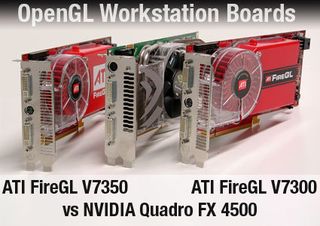OpenGL Workstation Graphics: Now We're Talking High End!
Introduction

Clocks tick slower in the OpenGL workstation arena. In contrast to graphics cards aimed at gaming, no manufacturer would even think of chucking products onto the market every four months. Instead, they concentrate on the good old virtues of market maturity and stability. And that's a good thing too, because technically, the hardware for OpenGL graphics cards is no different from its gaming counterparts - the price is three time as high, though!
In order for product positioning to have the desired effect, they use an "independent" label (FireGL instead of Radeon) and modify the card's BIOS and a bit of microcode in the chip. This means that users cannot run FireGL drivers on a Radeon card, and vice versa. The drivers themselves have built-in "artificial brakes", meaning that a gaming card can never achieve decent values in the OpenGL arena - that's reserved for workstation cards. As an aside, both ATi and Nvidia use the same process to position their individual products.
So what justifies the enormous price difference? The majority of the costs result from customer support and driver development. No OpenGL workstation user is allowed to be left alone with his problems, where it's the complete opposite for the gamer. Additionally, it takes a long time before OpenGL drivers can be certified as "stable", so the manufacturers pass these increased costs on to the customer. Why does no-one complain? That's easy: workstations for engineers and designers make a considerable contribution to creating value in the production process. Procurement costs are of little importance, since the workstations are a business expense, and mostly pay for themselves within a short time.
Now that 3Dlabs has stopped producing OpenGL cards, there are only two manufacturers left: the big boys, ATI and Nvidia. The THG lab in Munich tested the current FireGL boards V7350 and V7300 from ATi; the competing product from Nvidia is called the Quadro FX 4500, and although it is not exactly the newest product around, it can still hold its own, as our tests show.
Join our discussion on this topic
Stay On the Cutting Edge: Get the Tom's Hardware Newsletter
Get Tom's Hardware's best news and in-depth reviews, straight to your inbox.

Redditor allegedly purchased two Intel Arc B570 GPUs at Micro Center days before the official launch — the CPU couldn't recognize the GPUs due to the lack of driver support

Spanish retailer lists RX 9070 and RX 9070 XT GPUs, though the prices might be mere placeholders — RX 9070 for $912 and RX 9070 XT for $1,097
-
I just stumbled upon your blog after reading your blog posts wanted to say thanks.i highly appreciate the blogger for doing this effort. http://www.electrocomputerwarehouse.comReply
Most Popular

